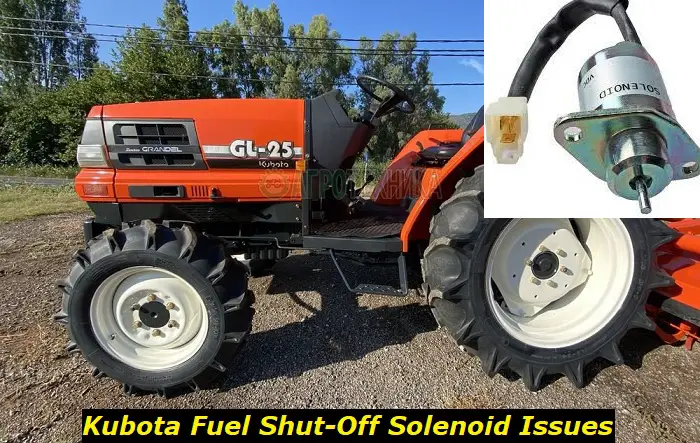Kubota Fuel Shut Off Solenoid Problems: Symptoms and Ways to Fix
Your engine may be giving you problems when running or trying to start or stop it. There are numerous reasons why an engine can act up, and unless you have an idea what is wrong, you will be in for a long, frustrating experience with your machine. The Kubota fuel shut off solenoid is one of the reasons why your engine might be giving you problems.
In our article today, we are going to explore the Kubota fuel shut off solenoid. We will find out the common problems that dog this unique fuel system component. To help us get a better glimpse of this component, we will find out the common symptoms associated with a malfunctioning fuel shut off solenoid from Kubota. Of course, we will find different ways to fix the said problems.

What is Kubota fuel shut off solenoid?
A fuel shut off solenoid is a widely used component in all combustion engines. It can be found in boats, tractors, cars, lawnmowers, and so on. The Kubota is a trusted brand, and many machines use fuel shut off solenoids from the company.
A fuel shut off solenoid is a gadget normally found near the engine next to the fuel pump. As the name suggests, it shuts off the fuel flow to the engine when you no longer want the engine to run. It is essentially a simple way to stifle the engine.
The Kubota fuel shut off solenoid is a valve operated electromagnetically to remotely cut fuel supply to an engine. This solenoid basically consists of two gadgets; one where the fuel flows through and an electromagnetic one where a plunger pops in and out to cut the fuel flow in the chamber where the fuel pump is.
Kubota fuel shut off solenoids are different for different vehicles, tractors, or other types of machines. Many of these solenoids are connected to a fuse which is easy to replace if it blows. In some Kubota solenoids, you will find two 12V wires going into the component. In most cases, one of the wires is blue and the other white. In other Kubota solenoids, an extra wire acts as a ground wire.
How does the Kubota fuel shut-off solenoid work?
As indicated above, there are wires running into the solenoid. Inside the solenoid chamber, there are two wire windings. The larger winding, whose wire comes directly from the starter, is linked with a plunger. When this winding is electromagnetically powered, the plunger pops out, allowing the fuel to run through the system. Another wire is of lower voltage and is used to power the second winding inside the solenoid to ensure the plunger stays out while the engine runs. Once the ignition is turned to the OFF position, the power to the solenoid is cut off, and the plunger pops back into the solenoid, cutting the fuel flow to the engine.
When you turn the ignition key to 'Start,' the battery powers the starter, which then turns the crankshaft and hence the engine. Turning 'off' the ignition key also means the fuel shut off solenoid is energized, which means that the plunger in the solenoid pops out. The popping out of the plunger means the fuel can flow just in time when the engine starts running. Turning off the ignition cuts power to the fuel shut off solenoid, making the plunger snap back inside the solenoid armature hence cutting the fuel flow.
What are the common problems of this fuel shut off solenoid?
There are all manner of problems that can make a Kubota fuel shut-off solenoid malfunction. Some problems are easy to solve and even preventable, while others are major and can damage other components. Here are some of the common problems you are likely to encounter with a Kubota fuel shut-off solenoid;
1) The solenoid dead
The solenoid can develop a fault to the extent of making it inoperable. The winding inside the solenoid can short, making the plunger fail to respond when you turn on the ignition key. Some debris might form inside the solenoid such that the plunger, which is mechanical, fail to move in or out.
Solution
The Kubota fuel shut off solenoid costs less than $40 in most shops. Where rewinding the armature is necessary to revive the solenoid, it will help to consider buying a new solenoid instead. A mechanic should test the solenoid to establish whether the electrical, mechanical, or magnetic component is faulty and whether it can be repaired or replaced.
2) Solenoid intermittent failure
Some people have encountered the Kubota fuel shut off solenoid and reported its intermittent failure. They report that the solenoid will sometimes shut off the engine just fine, and other times, the engine continues running even after turning off the ignition key. The problem normally lies with the plunger getting stuck.
The solution
According to many people who have experienced the problem, they have managed to resolve this issue by removing the solenoid and working on it on a bench. The solution can be a simple pulling and releasing the plunger. The Kubota brand tends to get stuck in many instances, and pulling the plunger several times helps solve the problem. Other times, the solenoid may fail to work because of debris in the boot. As stated earlier, it would be cheaper to replace the whole solenoid because it is not that expensive, and Kubota doesn't manufacture the boot anyway.
3) Solenoid fuse blown
Depending on the Kubota solenoid installed in your car, boat, or tractor, there could be one or two fuses. In some cases, the fuse for the main cable going to the solenoid is guarded by a 20-ampere fuse, and the cable maintaining the solenoid activated has a 5-amp fuse. Any of these fuses can blow, and this will cause the solenoid to stop working.
Solution
Before you disassemble a Kubota shut off solenoid, it is imperative that you first check the fuses. Replacing the fuse is easy and cheap. Ensure that you replace the fuse with the right one. Don't put a fuse with a different rating since it is likely to blow too.
4) Rats chewing the cables
Some users of this component have discovered its failure was caused by mice or rats chewing the harness and damaging the wiring to the solenoid. After being chewed, these wires can cause the solenoid to work intermittently or stop working totally. It can also be dangerous since there is a risk of wires shorting.
Solution
The answer to this problem is to repair or replace the wiring. Coat the wires with a harness and, of course, try and prevent rats and mice from accessing your machinery. Locating a wiring problem can be tough if you try to do it at home. Engage a professional who has the right tools and who will help you solve this problem to its entirety.
What are the symptoms of a faulty Kubota fuel shut-off solenoid?
- Engine not starting - The Kubota fuel shut-off solenoid is a sensitive component, and its malfunction can cause the engine to fail to start. Failure to start can be caused by poor wiring, a stuck plunger, or destroyed winding inside the solenoid.
- Engine not stopping - This is the most common symptom. When you turn the ignition to the 'off' position, the engine continues to run. This symptom is commonly associated with a stuck plunger in the solenoid. You should be on your way once you free the plunger, whose movement can be hampered by debris.
- Failed emissions test - The Kubota fuel shut-off solenoid can be part of an EGR system for some complex engines. This means a solenoid malfunction will affect the functionality of the EGR, which can lead to poor performance. The engine can emit excessive NOx emissions, leading to a failed emissions test.
- Check engine light - If the shut-off solenoid is installed in a boat, an RV, or a tractor, the check engine light might pop up whenever it malfunctions.
- Wiring gets fried - This is more of a repair or installation fault than a symptom. Remember, the Kubota fuel shut-off solenoid is powered by a thick wire which will most likely come from the starter. Once the ignition process is ended, the power to the starter is killed, and the solenoid is kept activated by a secondary cable. If the wiring is done wrong, the main cable may continue powering the solenoid, which will cause the winding inside to get fried.
Conclusion
The Kubota fuel shut off solenoid is popular and will be found in all manner of vehicles and machinery. It is also a preferred aftermarket replacement because it is efficient. But like any machine part, it comes with various faults, making it less than ideal. The good thing is that it displays some symptoms to help you trace the problem. Fixing the solenoid is not hard and is relatively cheap. The only question is whether it is more reliable than competition.

Add comment